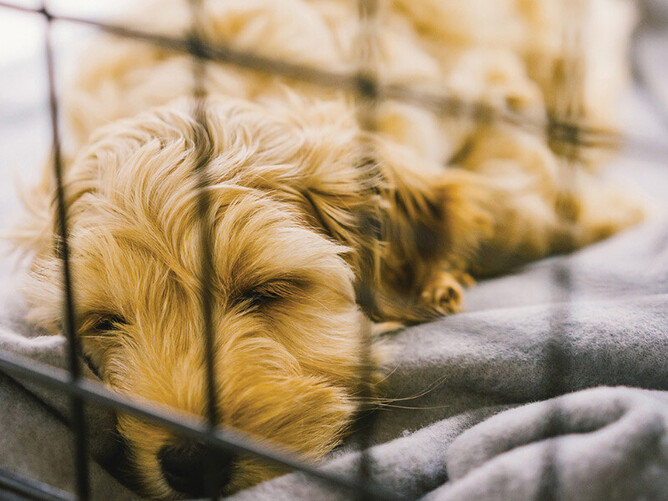Bringing home a new puppy is an exciting time, but it can also be a challenge, especially when it comes to crate training. Crate training can be one of the most challenging aspects of puppy ownership, but it is also one of the most effective ways to teach your puppy the rules of the house, prevent destructive behaviour, and create a safe, comfortable space where your puppy can relax and feel secure.
Whether your dog is new to your home or you're just looking for some expert tips on successful crate training, here are some tips to help you and your furry friend enjoy the experience and make the most of this valuable training tool.
Start Slowly
The first step to successful crate training is to start slowly. Start by introducing your puppy to the crate slowly and gradually.
Place the crate in an area of your house where the family spends a lot of time, such as the family room. Put a soft blanket or bed in the crate, take the door off or keep it propped open and let the dog explore the crate. Some dogs will be naturally curious and start sleeping in the crate right away (success!), however if yours isn't one of them:
Bring them over to the crate and talk to them in a happy tone of voice. Make sure the crate door is open and secured so that it won't hit your dog and frighten them.
Encourage your dog to enter the crate by dropping some small food treats nearby, then just inside the door, and finally, all the way inside the crate. If they refuse to go all the way in at first that’s okay, don't force them to enter.
Use some dog treats inside the crate and encourage your dog to walk calmly all the way into the crate to get the food. If they aren’t interested in the treats, try tossing a favourite toy in the crate. This step may take a few minutes or as long as several days.
Place your puppy in the crate for brief periods, gradually increasing the duration of time spent inside. Make sure to provide food and water in the crate, and plenty of toys and comfortable bedding to make the crate an enjoyable place for your puppy to be.
Progressive time in the crate
Follow these general steps to get your pup acquainted (and hopefully loving) their crate in no time!
Step 1
After introducing your dog to the crate, begin feeding them their regular meals near the crate. This will create a pleasant association with the crate.
If your dog is readily entering the crate when you begin the previous step, place the food dish or toy towards the back of the crate.
If they’re not keen to enter the crate, put the dish only as far inside as they will readily go without feeling anxious. Each time you feed them, place the dish a little further back in the crate.
Once your dog is standing comfortably in the crate to eat their meal, close the door while they’re eating. The first time you do this, open the door as soon as they finish their meal. With each successive feeding, leave the door closed a few minutes longer, until they’re staying in the crate for 10 minutes or so after eating.
If they begin to whine to be let out, you may have increased the length of time too quickly. Next time, try leaving them in the crate for a shorter time.
Step 2
After your dog is eating their regular meals in the crate with no sign of fear or anxiety, you can confine them there for short periods of time while you're home.
Call them over to the crate and give them a treat.
Give them a voice cue to enter, such as "crate." Encourage them by pointing to the inside of the crate with a treat in your hand.
After your dog enters the crate, give them some encouragement and a treat, and close the door.
Sit quietly near the crate for five to 10 minutes and then go into another room for a few minutes. Return, sit quietly again for a short time and then let them out.
Repeat this process several times a day, gradually increasing the length of time you leave them in the crate and the length of time you're out of sight.
Once your pup can stay in the crate for about 30 minutes with you mostly out of sight and without making a fuss, you can begin leaving them crated when you're gone for short time periods and/or letting them sleep there at night. This may take several days or weeks.
Step 3
After your dog can spend about 30 minutes in the crate without becoming anxious or afraid, you can begin leaving them crated for short periods when you leave the house.
Put them in the crate using your regular command and a treat. You might also want to leave them with a few safe toys in the crate.
Vary the moment during your "getting ready to leave" routine that you put your dog in the crate. Although they shouldn't be crated for a long time before you leave, you can crate them anywhere from five to 20 minutes prior to leaving.
Keep your departures short and sweet. Praise your dog briefly, give them a treat for entering the crate and then leave quietly.
When you return home, stay low-key and don’t over-excite them, as this will increase their anxiety over when you will return. Continue to crate your dog for short periods from time to time when you're home so they don't associate crating with being left alone.
Encourage Good Sleeping Habits
Dogs are naturally den animals and enjoy having their own personal space where they can curl up and rest. Crate training provides this space for your puppy and can be a great way to encourage good sleeping habits. Make sure to place the crate in a quiet and comfortable location, away from any distractions or noisy areas of your home.
Put your dog in the crate using your regular command and a treat. Initially, it may be a good idea to put the crate in your bedroom or nearby in a hallway, especially if you have a puppy. Puppies often need toilet breaks during the night and you'll want to be able to hear your puppy when they whine to be let outside. Older dogs should also initially be kept nearby so they don't associate the crate with social isolation.
Once your dog is sleeping comfortably through the night with the crate near you, you can begin to gradually move it to the location you prefer, although time spent with your dog—even sleep time—is a chance to strengthen the bond between you and your pet.
Avoid using the Crate as Punishment
One common mistake that pet owners make is using the crate as a form of punishment. This can lead to negative associations with the crate, making crate training more challenging. Instead, use the crate as a positive training tool and a safe, comfortable space for your puppy to retreat to.
Be Patient
Crate training requires patience and persistence. Don't expect your puppy to become comfortable in their crate overnight. Be patient, and don't force your puppy into the crate. If your puppy shows signs of discomfort or anxiety, slow down and work with them to make the crate a more comfortable and enjoyable space.
What to do if your puppy protests
If your pup is prone to whinging during the crate process, it can be tricky to figure out whether they're asking to come out of the crate or if they need a potty break. If you've refrained from rewarding them by letting them out in the past, then ignore their cries - even though we know how tempting it is not to! A good trick here is using a phrase that reminds them its bathroom time; if they perk up, let them outside to do their business ASAP (no playtime allowed!). But never punish them, just make sure you haven't moved through training steps too quickly before trying this technique.
Crate training is an essential part of puppy ownership, and with the right approach, it can be a rewarding experience for both you and your furry friend. By starting slowly, rewarding good behaviour, and being patient, you can help your puppy feel comfortable and safe in their crate and set them up for a lifetime of success. So, choose the crate that suits your puppy, get started slowly, and watch your furry friend thrive in their new home!



